-
Countries
-
Data and Analysis
-
Special Focus
-
Crisis Responses
Assessment Report
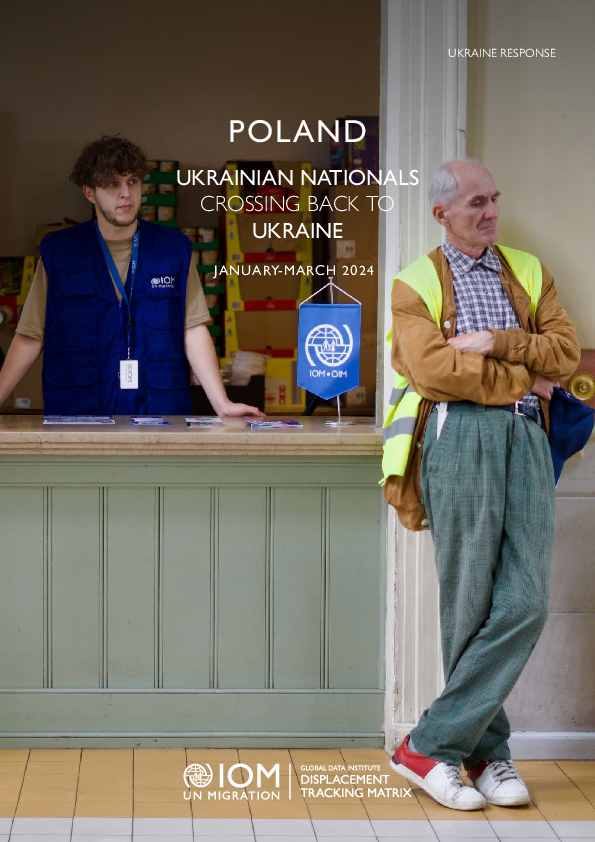
Contact
DTM Europe, DTMMediterranean@iom.int
Language
English
Location
Poland
Period Covered
Jan 01 2024
Mar 31 2024
Activity
- Survey
- Return Intention
- Flow Monitoring
IOM’s Displacement Tracking Matrix (DTM) collected data on Ukrainian nationals and Third-Country Nationals (TCNs) who crossed back to Ukraine from Poland, either for a temporary stay or permanent return after a period of displacement abroad. The survey focuses on the return intentions, duration of displacement, destinations, assistance, and experiences of discrimination of 361 Ukrainian respondents surveyed between January and March 2024.
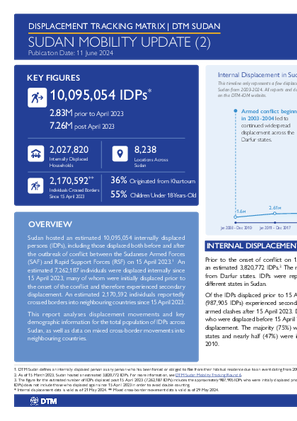
Contact
DTM Sudan; dtmsudan@iom.int
Language
English
Location
Sudan
Period Covered
Apr 15 2023
Jun 11 2024
Activity
- Mobility Tracking
- Baseline Assessment
This report reflects data corresponding to Sudan Mobility Update (2) dataset. The dataset is available here.
Overview:
This report provides an overview of the total population of internally displaced persons (IDPs) in Sudan, including those displaced both before and after the onset of conflict on 15 April 2023.
The displacement crisis in Sudan has been unfolding for over two decades, with roots in the Darfur conflict beginning in 2003. Prior to the onset of conflict on 15 April 2023, Sudan already hosted an estimated 3,820,772 IDPs. The majority (80%) reportedly originated from Darfur states, and most were initially displaced between 2003 and 2010. Of these IDPs, many experienced secondary displacement after 15 April 2023. Since 15 April 2023, an estimated 7,262,187 individuals were displaced internally within Sudan — including those who experienced secondary displacement.
When accounting for those displaced both before and after 15 April 2023, DTM estimated that Sudan hosted a total of 10,095,054 IDPs.
Key Findings:
- An estimated total of 10,095,054 IDPs were displaced across 8,239 locations, in 183 localities in all 18 states in Sudan.
- An estimated 7,262,187 individuals were displaced internally within Sudan since 15 April 2023.
- An estimated 26 per cent of IDPs who were initially displaced prior to the onset of current conflict experienced secondary displacement since 15 April 2023.
- Approximately 2,170,592 individuals crossed borders into neighbouring countries since 15 April 2023.
- The top states of origin among IDPs were Khartoum (36%), South Darfur (21%), and North Darfur (12%).
- The states hosting the most IDPs were South Darfur (18%), North Darfur (13%) and Central Darfur (9%).
- Over half (55%) of IDPs were reportedly children under the age of 18-years-old.
Note: The number of IDPs displaced post 15 April 2023 (7,262,187 IDPs) includes the estimated 987,905 IDPs who were initially displaced prior to 15 April 2023 and experienced secondary displacement since 15 April 2023. DTM Sudan defines an internally displaced person as any person who has been forced or obliged to flee from their habitual residence due to an event dating from 2003 onwards.

Contact
DTM Europe, DTMMediterranean@iom.int
Language
English
Location
Albania
Period Covered
Jun 08 2023
Sep 03 2023
Activity
- Survey
- Flow Monitoring
This report presents the results of the second round of the Displacement Tracking Matrix (DTM) Flow Monitoring Surveys (FMS) implemented in Albania. The data was collected across Albania from 8 June to 3 September 2023, with a total of 128 individual respondents.
FMS provides a snapshot of the profiles, experiences and needs of migrants transiting through Albania. The survey asks questions on demographics, education and employment backgrounds, the circumstances of the migration journey and migration factors, as well as future intentions.
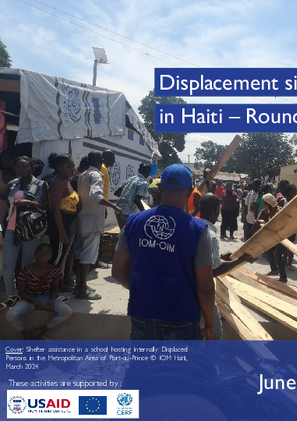
Contact
DTM Haiti, dtmhaiti@iom.int
Language
English
Location
Haiti
Period Covered
Apr 24 2024
May 31 2024
Activity
- Mobility Tracking
- Baseline Assessment
- Site Assessment
- Village Assessment
The Round 6, published in early March 2024, indicated that 362,551 people were
internally displaced in Haiti. This new Round indicates the presence of 578,074 internally displaced people, almost 60%
more than in Round 6. This increase is due to the deterioration of the security situation observed in the MAPAP, Haiti’s
capital, between the end of February and April 2024 in particular. The increase in the number of IDPs was more
identified in provinces where it increased by 95% (compared to 15% in the MAPAP). Indeed, following the increase in
violence in the MAPAP, many people fled the capital to seek refuge in provinces.
The Great South was the region that saw the largest increase in the number of IDPs hosted there (130% more
compared to Round 6). Nearly half (47%) of IDPs in the country are located in the Great South.
The majority of IDPs in the country are hosted in provinces: 68% in provinces vs. 32% in the MAPAP
The IDPs in provinces are mainly people who fled the MAPAP: 78% of IDPs in provinces came from the MAPAP.
Artibonite, where half of the IDPs fled areas located in this department, is an exception. In all other departments of the
country, IDPs mainly came from the MAPAP.
At the national level, the majority of IDPs are hosted by host families: 80% vs 20% in sites. However, in the MAPAP,
the majority of IDPs reside in sites (61% in sites vs 39% in host families), while in provinces the opposite is true (97% in
host families vs 3% in sites). It is crucial to support host communities in provinces, particularly in the Great South, to
enable them to continue hosting IDPs; and it is important to promote social cohesion between these two population
groups. Without the resilience of host communities, the number of sites in provinces is likely to increase as has been the
case in the MAPAP. Indeed, at the beginning of the crisis, the majority of IDPs in the MAPAP were hosted by host
families: only about 2 out of 10 IDPs were in sites in 2022; this figure increased to 6 out of 10 IDPs in 2023. One of the
main reasons for this increase was the lack of resources of host communities to continue hosting IDPs and the
deterioration of social cohesion in this context.
In addition, 50,000 returnees formerly IDPs were identified, particularly in the MAPAP, in Croix-des-Bouquets (21%),
Cité Soleil (14%), Port-au-Prince (12%); in the South in Tiburon (19%); and in the Center in Sauts d’Eau (10%). It should
be noted that for the moment these returns remain very fragile and are not sustainable, particularly in the MAPAP.
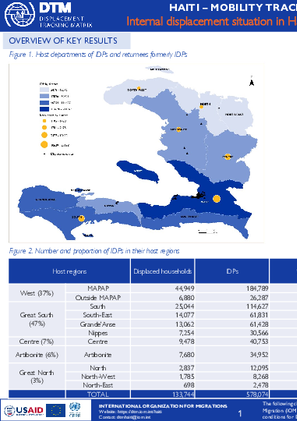
Contact
DTM Haiti, dtmhaiti@iom.int
Language
English
Location
Haiti
Period Covered
Feb 24 2024
May 31 2024
Activity
- Mobility Tracking
- Baseline Assessment
- Site Assessment
- Village Assessment
The Round 6, published in early March 2024, indicated that 362,551 people were
internally displaced in Haiti. This new Round indicates the presence of 578,074 internally displaced people, almost 60%
more than in Round 6. This increase is due to the deterioration of the security situation observed in the MAPAP, Haiti’s
capital, between the end of February and April 2024 in particular. The increase in the number of IDPs was more
identified in provinces where it increased by 95% (compared to 15% in the MAPAP). Indeed, following the increase in
violence in the MAPAP, many people fled the capital to seek refuge in provinces.
The Great South was the region that saw the largest increase in the number of IDPs hosted there (130% more
compared to Round 6). Nearly half (47%) of IDPs in the country are located in the Great South.
The majority of IDPs in the country are hosted in provinces: 68% in provinces vs. 32% in the MAPAP
The IDPs in provinces are mainly people who fled the MAPAP: 78% of IDPs in provinces came from the MAPAP.
Artibonite, where half of the IDPs fled areas located in this department, is an exception. In all other departments of the
country, IDPs mainly came from the MAPAP.
At the national level, the majority of IDPs are hosted by host families: 80% vs 20% in sites. However, in the MAPAP,
the majority of IDPs reside in sites (61% in sites vs 39% in host families), while in provinces the opposite is true (97% in
host families vs 3% in sites). It is crucial to support host communities in provinces, particularly in the Great South, to
enable them to continue hosting IDPs; and it is important to promote social cohesion between these two population
groups. Without the resilience of host communities, the number of sites in provinces is likely to increase as has been the
case in the MAPAP. Indeed, at the beginning of the crisis, the majority of IDPs in the MAPAP were hosted by host
families: only about 2 out of 10 IDPs were in sites in 2022; this figure increased to 6 out of 10 IDPs in 2023. One of the
main reasons for this increase was the lack of resources of host communities to continue hosting IDPs and the
deterioration of social cohesion in this context.
In addition, 50,000 returnees formerly IDPs were identified, particularly in the MAPAP, in Croix-des-Bouquets (21%),
Cité Soleil (14%), Port-au-Prince (12%); in the South in Tiburon (19%); and in the Center in Sauts d’Eau (10%). It should
be noted that for the moment these returns remain very fragile and are not sustainable, particularly in the MAPAP.

Contact
DTM Europe, DTMMediterranean@iom.int
Language
English
Location
Romania
Period Covered
Jan 01 2024
Mar 31 2024
Activity
- Survey
- Return Intention
- Flow Monitoring
IOM’s Displacement Tracking Matrix (DTM) collected data on Ukrainian nationals and TCNs (resided in Ukraine before 24 February 2022) that were crossing back to Ukraine from or through Romania, either temporarily or permanently. The survey focuses on the return intentions, duration of displacement, destinations, assistance, and experiences of discrimination of respondents. A total of 1,298 surveys were collected between January and March 2024. Among these, less than one per cent (n=11) were completed by TCNs, while the vast majority, comprising over 99 per cent (n=1,287), were completed by Ukrainian nationals. The analysis presented in this report is based on the responses provided by Ukrainian nationals.
Before crossing back into Ukraine, individuals commonly stayed in Romania (57%), other EU countries (36%) or non-EU countries (6%). Aside from Romania, other countries of residence were Bulgaria (18%), Germany (6%), Italy (4%) or Turkey (3%).
The travel intentions of the surveyed Ukrainian nationals show that most respondents (63%) were “short-term visitors”, while 15 per-cent were prospective returnees. Another 22 per cent were not sure regarding their visit period. Also, most UA citizens were travelling back to their oblast of origin (95%), with most respondents originating from Odeska, Chernivetska, City of Kiyv Mykolaivska or Kersonska.

Contact
DTM Burundi, DTMBurundi@iom.int
Language
French
Location
Burundi
Period Covered
Jul 01 2023
Dec 31 2023
Activity
- Survey
The Stability Index comprises data collected through interviews with key informants at local level (lowest possible administrative level) in target provinces affected by internal displacement and return movements of Burundian refugees from neighbouring countries. Key informants, including IDP and returnee representatives, community agents and Red Cross volunteers, were interviewed at each location by investigators in January 2024.
The use of key informants has the advantage of enabling wide geographical coverage. Several key informants were interviewed in each hill side, enabling IOM to triangulate in order to validate this information. In total, the 363 places of return and/or displacement assessed in the first (December 2022) and second (June 2023) rounds were also assessed in the third round in the same provinces of Cankuzo, Cibitoke, Kirundo, Makamba, Muyinga, Rumonge, Rutana and Ruyigi, to enable the observation of changes over time. Using the results of the DTM baseline assessments and the mapping of returnees provided by the United Nations High Commissioner for Refugees (UNHCR), hills were selected to identify areas with large numbers of displaced people and returnees. The recurrence of environmental hazards due to climate change and the large number of returnees were key factors in the choice of hills .
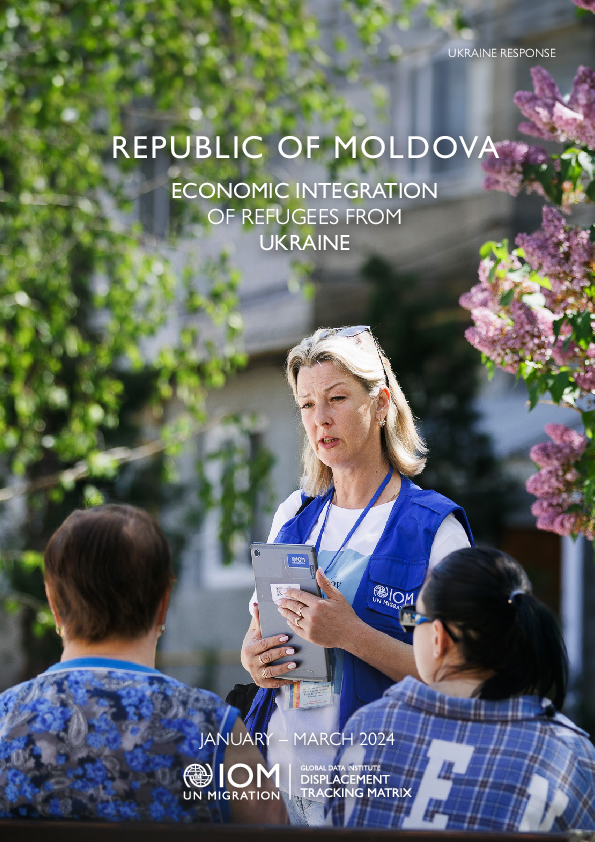
Contact
DTM Europe, DTMMediterranean@iom.int
Language
English
Location
Republic of Moldova
Period Covered
Jan 01 2024
Mar 31 2024
Activity
- Survey
- Flow Monitoring
The IOM’s Displacement Tracking Matrix collected data through Surveys with Refugees in the Ukraine Response region from January to March 2024. In the Republic of Moldova, a total of 1,507 surveys were collected. This report focuses on the economic integration of the respondents, delving deeper into their employment profiles, skills, and prospects for participation in the local labour market.
Key findings:
- 82% of the respondents possessed Temporary Protection Status. Others reported having: irregular status (13%), refugee status (2%), or residence permits (3%).
- 87% of the active respondents were employed in Ukraine before displacement. After being displaced in the Republic of Moldova employment rates were 49% among the respondents that actively participated in the labour market.
- Among employed respondents, 37% had an official working contract in the Republic of Moldova and 30% were working based on a verbal agreement. The remaining 33% had a remote working contract in another country.
- Two-thirds (66%) of men and 47% of women were satisfied with their working arrangement.
- Respondents reported an average monthly expenditure of 285 euro on rent and 110 on utilities.
- 44% of the surveyed households had a total monthly income of less than 400 euros.
- 65% reported receiving an average of 300 euros monthly in remittances from Ukraine.

Contact
DTM Europe, DTMMediterranean@iom.int
Language
English
Location
Serbia
Period Covered
Apr 01 2024
Apr 30 2024
Activity
- Survey
- Flow Monitoring
This report provides insights into the profiles, experiences and journeys of migrants transiting through the Republic of Serbia. Data was collected from 1 to 30 April 2024 together with the Commissariat for Refugees and Migrants of the Republic of Serbia (SCRM). The sample consists of 147 interviewed migrants in Asylum Centres (AC) Sjenica, (AC) Tutin, (AC) Krnjaca, (AC) Obrenovac, and Reception Centres (RC) Bujanovac, (RC) Presevo, (RC) Dimitrovgrad across the country.

Contact
DTM Europe, DTMMediterranean@iom.int
Language
English
Location
Slovakia
Period Covered
Jan 01 2024
Mar 31 2024
Activity
- Survey
- Return Intention
- Flow Monitoring
IOM’s Displacement Tracking Matrix (DTM) collected data on Ukrainian nationals and Third-Country Nationals (TCNs) that crossed back to Ukraine from or through Slovakia, either temporarily or permanently. The survey focuses on the return intentions, duration of displacement, destinations, assistance, and experiences of discrimination of respondents. A total of 1,335 surveys were collected between January and March 2024.
Key findings:
- 27% of Ukrainian respondents intend to stay in Ukraine (prospective returnees), while 68% plan to go for a short visit.
- The share of those intending to return to Ukraine is higher among men than women (49% vs 25%). Women are more likely to be crossing into Ukraine for a short visit than men (69% vs 44%).
- Most of the short-term visitors plan to stay in their own home in Ukraine (78% overall), while others report to be going to their relatives’ homes (10%), finding other private solutions (7%) or staying with friends (4%). The share of those planning to stay at home is higher among prospective returnees (98%) than among short-term visitors (78%).
- Reasons for returning for prospective returnees include: visit relatives or close friends (75%), meet with family members (6%), reunite with their family (6%).
- Reasons for returning for short-term visitors include: visit family members (76%), healthcare (26%), reunite with family (21%).
- 64% of the Ukrainian nationals originate from seven regions in Ukraine: Zakarpatska (21%), Kyiv (13%), Kharkivska (8%), Dnipropetrovska (8%), Odeska (6%), Zaporizka (3%), and Mykolaivska (3%). The remaining 36% of respondents come from another 20 regions across Ukraine.
Pagination
- Previous page
- Page 28
- Next page
